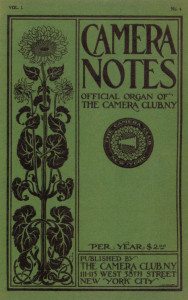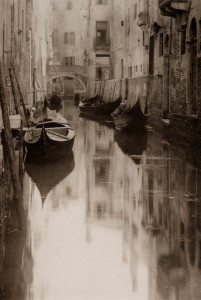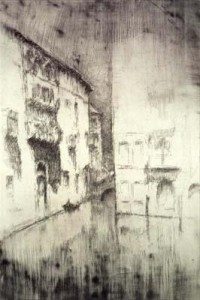Photo-Secession as Pictorialism
Part One
At the turn of the century, as the nineteenth century waned, it was quite possible to speak of a “beautiful photograph” or, more precisely, of a photograph of something “beautiful.” But that photograph had been made by a machine, the camera, and, thus, according to conventional wisdom, had no claim on aesthetics, that is, no claim upon art itself. In the collective mindset of the art world, “art” had to be a reflection of the artist him or herself, involving hand work and imagination, both of which were inherently unique to the artist and the individual’s personal touch. This accepted definition of “art” excluded any object touched by a machine from the precincts of art. Although it had been made through and with mechanical tools, even a piece of furniture had more status than a photograph, because the object had been designed by an artist. The only people who could question the prevailing definition of art were a new breed of photographers, known as “amateurs.” Today, the term amateur means untried and untrained and untested, in other words an individual who has little to offer, a hobbyist, someone who is simply not serious. Although the word is not necessarily a negative term, there are implications of a certain lack of polish or finish and certainly lacks the criteria famously put forward by Malcolm Gladwell in his 2013 New Yorker article, “Complexity and Ten Thousand Hours” as being the minimum expenditure for expertise. But in Europe, especially in England, the idea of an “amateur” was an honorable one, a concept that was tangled up in class. Only middle and lower class people needed (financially) to be “professional.” If one had the means, one should remain an “amateur” and devote oneself selflessly to a field. In fact the “amateur athlete” held up as the ideal for Olympic competitors can be traced back to the English tradition of gentlemen participating in sports. William Henry Fox Talbot, the great amateur scientist of the previous generation of scientists and photographers comes to mind as being part of the tradition of aristocratic dedication to progress. Talbot, more of a scientist, than a photographer, stated from the start that a photograph was a trace of “the pencil of nature.” Indeed, the very definition of a photograph, its raison d’être, was that it was a passive mode of recording reality. But even as a scientist Talbot was deliberately artful in his compositions, pointing to artistic possibilities for a photograph. Following in his footsteps, a new generation of amateurs, men and women of some monetary independence, who were photographers out of conviction, not out of necessity, put forward the revolutionary suggestion that, under certain circumstances, photography could be art.
There were really two questions: How could a photograph be a work of art and how could a photograph become accepted as art? Generally speaking in both Europe and in America, amateur photographers, who were also educated lovers of art, decided that a photograph had to visually demonstrate the attributes of a work of art–from the artistic creativity invention, experimentation and the willingness to push a medium to its limits to the formal and studied qualities demonstrated by a work of art. What is little noted in relation to the growing amateur movement is that decades before avant-garde tactics became accepted, the amateur photographers, many of whom were financially comfortable, did not hesitate to manipulate the supposedly fixed sequence of how a photograph was taken and developed. Intervening in the action of a machine, thwarting its supposed purpose of documenting and recording, was in itself an innovative act. The hand of creativity and experimentation could intervene with the machine and could disguise and even refute the supposed automatism of the camera. The idea that the hand of the artist could be present in a photograph and the argument that this artistic intervention transformed a mechanical product into the work of the talented mind and skill of a creator was brought to New York City by the son of German immigrant, the American photographer, Alfred Stieglitz (1864-1946). Much has been written about Stieglitz and yet, perhaps because of his many roles in the art world, he remains under appreciated. In order to properly discuss this artist, it is necessary to slice his life into career parts–art dealer, artist, art collector, art gallery owner, supporter of European avant-garde art, entrepreneur of American art, publisher of photographic journals, organizer of photographic communities, and the motivator behind the novel idea that a photograph could be a work of art. And these are the elements of his life’s work are not necessarily in that or any particular order. Famous for his boundless energy and penchant for not-stop talking and his need to dominate any situation, Stieglitz was a man of many parts, not the least of which was his role as the photographer of, the husband of and the dealer for America’s best-loved and most profitable artist, Georgia O’Keeffe (1887-1986). But for the purposes of this post, Stieglitz will be discussed as the leader of the Photo-Secession movement in America, the movement that supported and promoted the idea of photography as art.
In the fin-de-siècle period, the art world in America was not just small, it was tiny, consisting of a two dozen or so dedicated individuals who were involved with creating a modern institution for modern art and of about that many artists who were interested in being contemporary. There was an equally small audience in New York for the kind of avant-garde art being produced in France or Germany. At the turn of the century, New York’s most “cutting edge” artists, The Eight or the Ashcan School, were no less than three decades behind French Realism. Until Alfred Stieglitz began exhibiting art, “modern art” hardly existed in New York. On one hand, New York, as the headquarters for modern art in America, offered little scope for the avant-garde, but on the other hand, the field was wide open. All one needed was money and audacity, and Alfred Stieglitz had more than enough of both. Most historical accounts of Stieglitz stress his American identity and glide swiftly past his Jewish roots, but, like many sons of recent immigrants, he returned to the old country, Germany in 1881, for his education as an engineer to the Technische Hochschule in Berlin to be trained as an engineer. There are suggestions that Stieglitz lived a life of freedom and self-indulgence but it should also be remembered that his family had also moved back to Berlin, supposedly to keep him company. But despite the familial presence and instead of being shaped and polished with a European gloss, the wealthy American student found his vocation in a new art form, photography.
Having spent much time working with his mentor, Hermann Wilhelm Vogel (1834-1898), who was a photochemist, Stieglitz decided to make a vocational change–instead of educating himself of a job as an engineer, he would live the life of an artist. Vogel’s career path and achievements provided a model for the young Stieglitz. Vogel was a pioneer in the research into color photography. Before his work, photographers were irritated that uniform of gray tones suppressed the true intensities of actual colors. But Vogel’s new color sensitive process allowed the camera to acknowledge colors as higher pitched or lower pitched tones of grays. In addition, Vogel was a tireless promotor of photography as art, publishing not only a technical manual for photography, Photographische Mitteilungen, but also founding the Photographic Society in Berlin in 1863 which gave birth to numerous successors, the Society for the Promotion of Photography, the German Society of Friends of Photography in 1887 and the Free Photographic Union in Berlin in 1889. While he can hardly be termed an “amateur,” Vogel, who trained Stieglitz at the Berlin “high” school, was a promotor of photography, and this role as promoter would be the destiny of Stieglitz. The American, who also studied at the Realgymnasium in Karlsruhe, honed his skills in Europe and was soon published in the British journal Amateur Photographer. His work in this early period followed the now established cadences of what is now called “Pictorialism,” soft focus, narrative scenes of every day life, and romantic views, all resembling traditional prints or watercolors. He also began writing articles, such as, “A Word or Two about Amateur Photography in Germany,” which gave him even more cultural capital, to take back home to America. It is possible that his family gave up on keeping their son under their control and, by 1884, the Stieglitz household had returned to New York. Fully prepared to bring New York to the level of Europe when it came to art photography, Alfred Stieglitz arrived in 1890, ready to make his mark.
In New York, Stieglitz continued his direction as an art photographer, finding some like-minded colleagues. Recognized as a natural leader, by 1893, he became the co-editor and main contributor for The American Amateur Photographer, where his energy and ambition proved to be overpowering for a genteel organization which roused himself to fire him.
Undeterred, Stieglitz then joined the Camera Club of New York and founded Camera Notes in 1897, undoubtedly in hopes of using another group of amateur photographers and the in-house publication as a vehicle for what were essentially his personal ambitions. Camera Notes, often overshadowed by its successor, Camera Work, but it set high standards for printing photographs as photogravures. A photogravure is not an actual photograph but a print, an engraving, of a photograph, so artistic in and of itself that it is considered an artistic equivalent of the original. It was here in this publication in 1898 that a beautiful example of the Pictorialism of Alfred Stieglitz, Canal in Venice, taken in 1894 while he was on his honeymoon.
This image embodies not only the precepts of Pictorialism–that a photograph should look like a picture–but also demonstrates how a photographer can emulate the aesthetics of an artist. To anyone familiar with the history of art, this photograph reflects the etchings of James Whistler and even the drawings of John Ruskin.
James Whistler. Nocturne. Palaces. Venice (1879-80) and John Ruskin. Part of St. Mark’s. Venice (1846)
One can determine the divergence between the interests of the Camera Club of New York and the restless Alfred Stieglitz by pursuing an account of the December 1899 proceedings of the Club in which “..the committee on photo research, it was stated, was carrying on a series of experiments with persulphate of ammonia, and would soon report results to the club..” The writer reported that a certain “Mr. Waterman” was awarded “the President’s cup” for “a sketchy landscape, artistically attractive, of a very simple subject..” There was also a “Murphy cup” competition in which “The award went to Mr. Stieglitz.” Having disposed of the artistic events, the Camera Club settled down to the feature entertainment, “an exhaustive and interesting scientific paper on ‘The Chemistry of Gelatin Emulsions and of the Dry Plate.’ It was based on one or more of the halides of silver in gelatine,” the write-up began and continued for a long paragraph which makes for exhaustive readings. One can only imagine was sort of torment was suffered by those present but these proceedings show the fascination amateur photographers and for scientific experimentation and suggest that, at the turn of the century, much of the advances in photography would have been literally donated by these dedicated individuals. But one also get the sense of how Camera Notes and its emphasis on art is at odds with a paper which instructed that “Experiments showed that it is always necessary in solutions of gelatine and silver mohave the silver in excess.” It should have been of no surprise to no one, and perhaps to the relief of some, that in 1903, Alfred Stieglitz determined that the Camera Club of New York and Camera Notes had served their ends and no longer served any of his needs.
In 1902, the term “Photo-Secession” was used by Stieglitz as the designation for a group of photographers following his artistic lead in the exhibition, mounted by the photographer himself at the National Arts Club, of the American Pictorial Photographers. By the twentieth century, the tireless efforts of Stieglitz as a promotion, American Pictoralists were as respected as those of Europe, but there was no outlet for this growing movement of art photographers beyond private clubs and exhibitions. What was needed was a more public forum so that the real task of introducing to the public at large or at least to the wider art world the photograph as a work of art. The word “Secession” was not an American word, nor was it an American concept, except as a political act. In England, vanguard Pictorialists seceded from conservative associations and formed their own groups, most famously, The Brotherhood of the Linked Ring in 1892. The word “secession” was an English translation of the action taken by vanguard German artists in Munich 1891 to “secede” from the conservative art establishment Künstlergenossenschaft. Eight years, the artists in Berlin, led by Impressionist Max Liebermann, seceded in 1899 from the Verein Berliner Künstler. It was remarkable at how quickly the provincial city of New York, led by Stieglitz, followed in the footsteps of these sophisticated art centers. Stieglitz, who was working closely with his protégée, Edward Steichen (1879-1973), studying in Paris, was well acquainted with European avant-garde movements–from a distance, thanks to Steichen. However, the older man understood well enough that it was impossible to reform a conservative organization from the inside; it was necessary to step outside to start again and to fully realize the avant-garde dream of doing something new, something else. It is beyond the scope of this post to develop this point, but the founding of the Photo-Secession by Alfred Stieglitz in New York, mirrored the Secessionist movements in Berlin and Vienna, both of which were funded and supported and led by Jews in the art world. This fact seemed to mean little in New York in the early 1900s and Stieglitz did not go out of his way to stress his Jewishness until the Hitler years of the 1930s aroused his consciousness and his fears. But there were those who were profoundly aware of his religion and Waldo Frank’s seminal description of Stieglitz in Our America (1919) defines the very nature of his work as Jewish:
Alfred Stieglitz is a Jew. He takes up the ancient destiny where the degenerate Jew whom we have observed had let it fall. He is the prophet. And his ways are the old ways of his people. He has been the true Apostle of self-liberationina in a destructive land. His means was art. But art always as a means. Stieglitz is primarily the Jewish mystic. Suffering is his daily bread: sacrifice is his creed: failure is his beloved. A true Jew.To him, art is simply the directest conduit to human consciousness–to self and to the world; the most urgent incentive left to man. For the most surely a man finds itself, and finds the world he lives in, the more surely he finds God. Art with a message is a profanation. The artist must simply be the servant of the soul, worshiper of the revelation of his life. As such, Stieglitz made a place for him in the American world, gave him warmth and courage. He is a man who has seen God and who has dared to speak..
The next post will discuss Alfred Stieglitz and the Photo-Secession.
If you have found this material useful, please give credit to
Dr. Jeanne S. M. Willette and Art History Unstuffed. Thank you.



